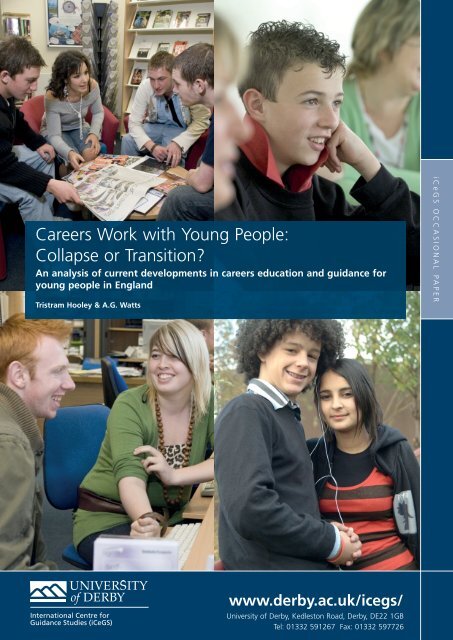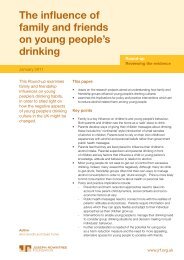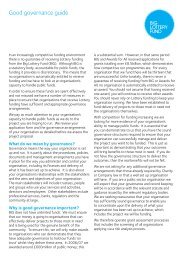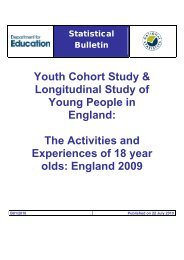cegs occasional papper - Partnership for Young London
cegs occasional papper - Partnership for Young London
cegs occasional papper - Partnership for Young London
- No tags were found...
Create successful ePaper yourself
Turn your PDF publications into a flip-book with our unique Google optimized e-Paper software.
Careers Work with <strong>Young</strong> People:Collapse or Transition?An analysis of current developments in careers education and guidance <strong>for</strong>young people in EnglandTristram Hooley & A.G. Wattsi C e G S O C C A S I O N A L P A P E Rwww.derby.ac.uk/i<strong>cegs</strong>/University of Derby, Kedleston Road, Derby, DE22 1GBTel: 01332 591267 Fax: 01332 597726
Careers Work with <strong>Young</strong> People: Collapse or Transition?Executive summaryThis paper analyses the current in<strong>for</strong>mation available (in July 2011) about the changes that are taking place incareers work following recent government policy initiatives and public-sector austerity measures. In particular, itexamines the local developments that have emerged in relation to a national policy context in which:• Existing careers work is being radically reconfigured.• The new National Careers Service (NCS) will principally serve adults (apart from its telephone/web-basedservices, which will cover young people too).• Securing careers guidance <strong>for</strong> young people has been made the responsibility of schools.• The requirement <strong>for</strong> schools to provide careers education has been removed.• There has been very limited transition planning at national level: this has led to considerable localconfusion.• In particular, there is continuing confusion about the future relationship of remaining face-to-faceConnexions services to the NCS, and about the branding of such services.Implications <strong>for</strong> Connexions services, Local Authorities, schools, new market players and the careers professionare identified:Connexions services• Connexions services have been seriously damaged by the new environment. Most have made staff cuts,closed centres and undertaken restructuring processes. Some have reduced face-to-face services in favourof remote delivery.• Many Connexions services have abandoned or reduced universal careers services and focused theirservices on vulnerable young people.• Some Connexions services are developing an offer <strong>for</strong> schools to buy into.• The Connexions brand seems likely to disappear in a growing number of areas.Local Authorities• Most Local Authorities have responded to the new policy environment by cutting funding to Connexionsservices, to a greater extent than the cuts to other services.• Some Local Authorities have sought a way through the transition by restructuring (frequently byabsorbing the remaining Connexions service into the Local Authority).• Other Local Authorities have begun to explore ways to facilitate the creation of a local school-centredmarket in careers services.• It is possible to summarise the main Local Authorities strategies as follows:o Extreme cutting (at least 12 Local Authorities).o Focusing solely on vulnerable young people (at least 49 Local Authorities).o Wait and see (at least 49 Local Authorities).o Working to sustain universal career guidance (at least 15 Local Authorities)Schools• The situation <strong>for</strong> schools is challenging: in addition to the erosion of Connexions, they have also lostsupport from Aimhigher and Education-Business <strong>Partnership</strong>s.• The removal of the statutory duty to provide careers education could result in a focus on “activities”i
Careers Work with <strong>Young</strong> People: Collapse or Transition?rather than on a developmental curriculum.• Many schools are unclear what their new responsibilities are and how best to discharge them.• Some schools are exploring how best to deliver career support, with internal, external and multi-schoolmodels being explored.• It is unclear how much resource schools will be able and willing to allocate to career support services, butit seems likely in most cases to be much less than previous provision.New market players• There is some evidence that new players are entering the school careers market, e.g. educationalagencies, private career support providers and IT-based solutions.The careers profession• The current environment is having a potentially disastrous impact on the careers profession. In particular,the following issues are causing concern:o Reduction in the number of posts.o Downward pressure on pay and conditions.o Loss of specialist careers roles within Local Authorities.o Loss of experienced staff from the profession.• These challenges to the careers profession could throw the wider project of re-professionalisation, beingencouraged and supported by the Government, into doubt.Local Authorities have limited scope within which to react to the changes that have been made by theGovernment. However, there is currently considerable diversity in the models that have begun to emerge. Theseinclude:• Abandonment of universal careers work.• Stretching of existing resources to continue to deliver a comparable (if significantly reduced) service.• Encouraging school-based modes of delivery around either a single-school or multi-school approach.• Development of a contracting-in approach to the delivery of careers services.This new situation has emerged as a direct result of Government policies and actions. The paper discusses thisnew policy framework and concludes that:• A new kind of market in careers work is beginning to emerge as a result of the current environment.• This market is centred around schools as the sole consumers of careers services, effectively excluding allother stakeholders from direct market participation.• Responsibility <strong>for</strong> resourcing career guidance has been moved from Local Authorities to schools, butwithout any transfer of funding.• This is likely to reduce substantially the overall capacity to deliver career support <strong>for</strong> young people.• The Government needs to review its roles in relation to the market in career support, in terms of:o Stimulating the career support market in order to build its capacity.o Regulating this market and assuring the quality of services within it.o Compensating <strong>for</strong> market failures.The paper concludes by setting out some key policy questions <strong>for</strong> the Government, <strong>for</strong> Local Authorities, <strong>for</strong> thecareers profession, and <strong>for</strong> schools.ii
Careers Work with <strong>Young</strong> People: Collapse or Transition?1. IntroductionThis paper is an attempt to synthesise some of the current in<strong>for</strong>mation related to the transition that is takingplace in careers work with young people, including the role of previous Connexions services; to analyse thisin<strong>for</strong>mation; and to develop some conceptual models to in<strong>for</strong>m future development. The main focus is onschools, though many of the points made are also relevant to colleges and to training providers.The provision of career guidance to young people has a long if somewhat chequered history in public policy.Peck (2004) argues that government policies in this area have been characterised by a growing awareness ofthe public value of career guidance, but also by an uncertain administrative framework. The current transitionalsituation demonstrates this clearly: whilst there have been strong endorsements by the new CoalitionGovernment of the value of career guidance (see Watts, 2011a), the framework that is emerging <strong>for</strong> its deliveryis uncertain and possesses considerable risk elements.Yet there is a considerable evidence base on the social and economic impact of career guidance with youngpeople (Hughes & Gratian, 2009). A recent literature review on careers work in schools (Hooley, Sampson &Marriott, 2011) concluded that impacts could be identified in retaining young people within education,motivating their academic achievement, supporting their transition to further learning and work, and enablinglife and career success. Other research demonstrates that career guidance can impact positively on economicproductivity (Access Economics, 2006) and social equality (Hutchinson et al., 2011).It is in this context that the current Government has enacted a raft of policies and funding decisions that areradically reframing the way in which careers work is delivered to young people. Key elements of the new policyenvironment (<strong>for</strong> a more detailed analysis, see Watts, 2011a) include:• Changes set out in the Education Bill, notably the removal of the requirement to provide careerseducation and the enactment of a new statutory duty <strong>for</strong> schools to “secure that all registered pupils atthe school are provided with independent careers guidance during the relevant phase of their education”(though with the clarification that this can be met, minimally, through providing access to web-based ortelephone services).• The merging of Connexions funding into the Early Intervention Grant, which is to be reduced by 10.9%to £2,212m in 2011/12 and then increased by 3.8% to £2,297m in 2012/13.• Guidance from the Department <strong>for</strong> Education (2011) which indicates that Local Authorities no longerhave a responsibility to provide universal careers services.• The effective deletion, through a combination of cuts and the removal of responsibility, of around £200million of funding (the notional careers-related Connexions funding) from the careers sector.• The development of a National Careers Service, which is theoretically an all-age service but in practice isto be mainly focused on adult advice and guidance (supported by funding of £84 million from theDepartment <strong>for</strong> Business, Innovation and Skills), with its directly-funded services <strong>for</strong> young peopleconfined to telephone- and web-based services (supported by funding from the Department <strong>for</strong>Education of £4.7 million (DfE, 2011c)).• The lack of any strategic transitional plan from the Government.These decisions have rapidly fed through from the policy level and have already begun to unravel existingservice-delivery models. New arrangements have begun to develop in advance of the legislative framework thatwill ultimately support them if the Education Bill is passed. In particular, the financial and political drivers onLocal Authorities have been sufficient to ensure that many of them have sought to make savings and/or repositionthemselves in anticipation of the passage of the Bill. This has led Unison (2010) to argue that manyLocal Authorities are failing to comply with their legislative duties.1
Careers Work with <strong>Young</strong> People: Collapse or Transition?This paper will attempt to map what is happening in these complex transitional arrangements and to identifysome of the patterns that are emerging. In<strong>for</strong>mation was collected from a range of sources including:1• A survey carried out <strong>for</strong> the Institute of Career Guidance (Nicholls, 2011).• In<strong>for</strong>mation passed to us from Unison, including the Unison Survey Findings (Unison, 2011a).• In<strong>for</strong>mation passed to us from Careers England.• In<strong>for</strong>mation solicited from Local Authority participants in the online community of practice concernedwith “Careers Guidance” (www.communities.idea.gov.uk) following the post of a draft of this paper andof the accompanying dataset.• In<strong>for</strong>mation posted on Tristram Hooley’s blog (http://adventuresincareerdevelopment.posterous.com) inresponse to calls <strong>for</strong> submissions.• The collection of Google alerts triggered by the keywords “Connexions cuts” between 27 July 2010 and5 July 2011. This mainly picked up local and trade press articles.• Private correspondence with Connexions staff and other key players.• The Connexions cuts database compiled by A Thousand Cuts (2010).• Using Google News searches to fill gaps.To date, in<strong>for</strong>mation has been secured relating to 144 of the 150 Local Authorities (96%). The in<strong>for</strong>mation thathas been gathered was collected from different sources <strong>for</strong> a range of different purposes and does not all coverthe same issues. Accordingly, figures given in this paper should be seen as minima rather than actual figures.Sources are named where possible, although several people who contacted the authors of the report asked toremain anonymous.2. Understanding the nature of the changeMuch commentary so far has focused on the cuts to Connexions services in terms both of the reduction ofservices to young people and of the impact on careers professionals through redundancies and restructuring.However, the decision to make cuts to young people’s careers services is only one part of the story. Equallyimportant has been the lack of any national transitional plan <strong>for</strong> managing the change.One implication of this lack of a transitional plan is that national resources which have been developed tosupport local Connexions work are currently languishing. Critically, the Connexions Direct site and the Jobs4Udatabase have been replaced with an inelegant redirect page that sends users to one of the following:• Directgov><strong>Young</strong> People.• In<strong>for</strong>mation about accessing distance guidance services on a degraded version of the Connexions Directsite.• The job profiles section of the Next Step website.• An archived version of the Connexions Direct site.• A new item on the DFE website.At present no publicly visible plan exists to indicate how this messy interim situation will be resolved. Theexisting Connexions Direct resources are to be merged into the new National Careers Service. However, thePrime Minister’s Office (2011) has publicly supported discussions relating to a What’s Your Destination(http://www.whatsyourdestination.co.uk/) initiative which seems to offer an alternative site with somewhatsimilar aims. It is unclear how this latter site will be funded and how it will relate to the NCS site.1 A full data set is available from the iCeGS website.2
Careers Work with <strong>Young</strong> People: Collapse or Transition?A further implication of the lack of national transition planning has been considerable confusion as the variouslocal stakeholders have wrestled with the implications of the new policy decisions. In South <strong>London</strong> (Bromley,Croydon, Merton, Richmond, Sutton), <strong>for</strong> example, this has meant disputes between stakeholders about whoholds the responsibility <strong>for</strong> employing and making staff redundant. For those involved in planning at the locallevel, it has been unclear what will be provided at the national level. Consequently, diverse models of localdelivery are emerging, which this paper will attempt to describe.A key outstanding issue is the relationship of remaining Connexions services to the new National CareersService (NCS). It seems clear that direct Department <strong>for</strong> Education funding <strong>for</strong> the NCS is to be confined totelephone- and web-based services (see Section 1 above). But John Hayes, the Minister responsible, has statedthat: “I want organisations that are part of the national careers service to provide in<strong>for</strong>mation, advice andguidance of such quality that schools will commission their services” (Hayes, 2011). The only face-to-face careerguidance providers that at present are assured to be part of the NCS are those which have existing contractswith the Skills Funding Agency (SFA) to provide career in<strong>for</strong>mation, advice and guidance to adults. The currentassumption seems to be that if schools purchase their services, this will be outside their NCS contracts, but thattheir NCS quality standards will still be applied (John Hayes stated that the NCS “will provide a visible publicplat<strong>for</strong>m which champions the quality and professional standards, which I think are crucial to the reestablishmentof careers guidance as a true, respected profession” (ibid)). Given this, questions remain abouthow the NCS’s role as a “public plat<strong>for</strong>m” <strong>for</strong> careers work will operate in practice and how it will relate, if atall, to previous Connexions face-to-face services that are not managed by NCS contract holders.A linked issue is branding. It seems that the Connexions brand is viewed fairly widely (whether justly or unjustly)as being tarnished, and is likely to disappear in a growing number of areas. If the NCS brand cannot be appliedto local face-to-face services <strong>for</strong> young people (except loosely by association in the case of suppliers with SFAcontracts <strong>for</strong> work with adults), there will no longer be a publicly discernible service that can provide the basis<strong>for</strong> marketing and publicity.The frequent co-location and shared management structures of Connexions and Next Step providers also raisesome issues about the potential impact of cuts to Connexions on the infrastructure of the new NCS. There area number of Local Authorities in which both the back-office functions and high-street presence of the twocareers services have been shared. The diminution or closure of Connexions is there<strong>for</strong>e likely to have an impacton the viability of NCS contracts <strong>for</strong> services to adults. Indeed, the issue runs deeper still, since Connexionscompanies have frequently acted as hubs <strong>for</strong> other educational and social welfare contracts. The removal ofConnexions funding (or its atomisation into smaller pieces within Local Authorities) there<strong>for</strong>e has the potentialto adversely affect the local infrastructures through which both young people and adults are supported in arange of ways.This paper’s description of the transition will examine in turn the behaviour of a range of different stakeholders,as follows:• The organisational structures and continuity of existing Connexions services.• The role of Local Authorities in the management of the transition.• The responses of schools to the changed situation.• The emergence of new market players.• The impact on the careers profession.3
Careers Work with <strong>Young</strong> People: Collapse or Transition?But how far Local Authorities seek to work within these principles is likely to be highly variable. In response toreductions in their funding, many Local Authorities have cut funding to Connexions services, to a greater extentthan the cuts to their other services. As a recent statement from careers sector employers, professional bodiesand unions stated, the current situation has “permitted local authorities to treat the existing careers guidanceservices as a soft target <strong>for</strong> cuts in advance of the transfer of statutory responsibility” (Careers England et al.,2011).Respondents to the survey of careers workers by the ICG (Nicholls, 2011) reported that many Local Authoritiesare already ceasing to provide universal careers services, although retaining some level of support <strong>for</strong> vulnerableyoung people. Despite Local Authorities moving to make staffing and service cuts in relation to Connexions,there was evidence of lack of strategic planning in many places, exacerbated by continuing confusion relatingto the respective responsibilities of Local Authorities and schools.However, some Local Authorities have responded in a more strategic way. In some cases, this has involvedrestructuring: <strong>for</strong> example, closing the Connexions organisation and integrating it into the Local Authority (e.g.Derby/Derbyshire, Surrey), TUPEing external employees into Local Authority employment (e.g. Brighton & Hove,Here<strong>for</strong>dshire), restructuring Connexions into an integrated youth service (e.g. Durham, Haringey) or floatingstaff out into a new organisation (e.g. Northamptonshire has established a “community interest company”which will offer an integrated youth service including career guidance). The extent to which multi-agency teamscontain distinctive careers roles is unclear, but is likely to be much less than in the past. This seems likely toproduce further erosion of the distinctive professionalism of career guidance practitioners – in directcontradiction to Government policies in this respect (see introduction to Section 2 above, and Section 2.5below).Other Local Authorities have made some initial moves to develop a transitional offer. These include many of thechanges to service delivery already listed in Section 2.1 (shifting the balance to more targeted delivery,developing paid offers <strong>for</strong> schools, etc.) as well as more strategic moves such as establishing a means ofsupporting schools in procuring and purchasing careers services from other organisations. For example, Leeds isissuing an approved list of career guidance providers <strong>for</strong> schools; whilst Blackburn with Darwen has workedwith schools and the local Connexions company to establish an Education Improvement <strong>Partnership</strong> (EIP) thatcan support consortia approaches to sharing strategy, practice and procurement arrangements.In addition, Local Authorities retain the responsibility (which was previously dealt with by the Connexionsprovider) <strong>for</strong> tracking young people and providing the data that will underpin the new destination measure(DfE, 2011b). It remains unclear how the logistics of this process will be managed to ensure reliable and validdata, given that this activity has previously been heavily dependent on a network of Connexions PersonalAdvisers, a data infrastructure typically managed by Connexions services, and a close link between tracking andhelping interventions (a link which now seems likely to be significantly uncoupled).It is possible to summarise the main Local Authority strategies as follows:1. Extreme cutting. In at least 12 Local Authorities, the Connexions service has been radically cut, oftenalongside cuts in other related services. In these areas, very little remains of the careers element ofConnexions and even the services <strong>for</strong> vulnerable young people have been pruned.2. Focusing solely on vulnerable young people. At least 49 other Local Authorities have removed orreduced the universal careers element of the Connexions service, and have restructured the service tofocus exclusively on support <strong>for</strong> vulnerable young people. A key issue in these Authorities in particular ishow vulnerable young people are defined. One Local Authority manager described his Authority as being“in a process of reviewing and re-defining what we mean by vulnerable young people…to ensure that itis not a crude and unhelpful cut-off”.5
Careers Work with <strong>Young</strong> People: Collapse or Transition?3. Wait and see. At least 49 Local Authorities have maintained some universal careers element in theirservice provision, although often with considerable resourcing cuts. These authorities may decide toreview this position following the passage of the Education Bill.4. Working to sustain universal career guidance. At least 15 Local Authorities have worked to maintaina substantial universal careers element in their service provision.2 A careers adviser quoted on the Unisonwebsite describes how his Local Authority has dealt with cuts: “I work in an area that takes careersguidance and the futures of its young people very seriously. Despite the cuts, the local authority hassought to distribute the cuts equally at local level and has not singled out Connexions as easy prey – assome other local authority areas seem to have done.” It remains to be seen whether the LocalAuthorities that have demonstrated their valuing of career guidance in these ways will be able tomaintain this stance following the passage of the Education Bill.For the remaining 25 Local Authorities, insufficient in<strong>for</strong>mation is available to permit categorisation in theseterms.Given these changes, a key question that will be addressed in Section 3 of this paper is which of the differentmoves that are being made by Local Authorities prefigure or interact with the longer-term models that will needto be developed if the Education Bill becomes law without significant amendment.2.3. The responses of schools to the changed situationFor schools, the situation is challenging, as they have suddenly been allocated a new responsibility to procure aservice which they had previously received free of charge. Furthermore, schools have not just lost the serviceprovided by Connexions but also those provided by, <strong>for</strong> example, Aimhigher and Education Business<strong>Partnership</strong>s. The policy of school autonomy means that the Government envisages schools solving theseproblems largely on their own and, importantly, out of their existing funds (except <strong>for</strong> schools with substantialpupil-premium funding).Some schools are experiencing difficulties in simply understanding the nature and extent of the changes. OneConnexions employee contacted the authors of this paper to say: “Schools seem generally unclear about whatwill be happening with careers and in the school I am based, it appears to be lost in the massive changesoccurring due to becoming an academy!” Another Connexions manager noted: “What they (schools) do notfully appreciate is the disappearance of any local careers infrastructure. There will be no local careers centre andno out of hours/out of term provision other than telephone/on-line unless a school purchases this.” However, inmany areas the Connexions Service has undertaken the role of communicating the new policy to schools andhelping them to work through the implications. For example, in Solihull schools have been working withConnexions staff to develop a mutually acceptable paid offer <strong>for</strong> the period after March 2012 when the currentoffer ceases.This new situation raises a number of challenges:• Understanding the shifting context and recognising their new responsibilities within it.• Making strategic decisions about what kinds and levels of services to provide and/or procure.• Developing systems and processes to enable the procurement of services.2 The Local Authorities identified within this category are Blackburn with Darwen, Buckinghamshire, Bury, Calderdale, Gateshead,Hampshire, Hert<strong>for</strong>dshire, Kirklees, Lincolnshire, Redbridge, Sandwell, Solihull, Somerset, Stoke-on-Trent and Tel<strong>for</strong>d & Wrekin.6
Careers Work with <strong>Young</strong> People: Collapse or Transition?Schools are managing this in a number of ways. Many remain keen to continue to deal with the sameorganisations and/or individuals that they previously dealt with, as this is “the easiest thing <strong>for</strong> busyheadteachers to do” (email from a School Governor). In some of these cases, named individuals are beingspecified, to assure quality. The nature of what schools are buying in will be discussed in Section 3.Other schools, however, are exploring alternative ways to deliver careers services. One Connexions advisercommented: “Early feedback from the schools is that they have lost trust in the LA and they will be trying tofind ways of delivering this themselves, either by employing an advisor directly or by using existing schoolstaff.”Finally, there is the question of how much schools are able and willing to pay <strong>for</strong> career guidance, especiallywhen it is competing <strong>for</strong> funds with a wide range of other valuable services (including, <strong>for</strong> example, centralisedsports co-ordination, educational psychology and welfare services), not to mention their own staffing budgets.Certainly there are a number of schools which have a track record of strong investment in careers work (anexample is Newstead Wood School in Bromley, which employs a full-time careers professional and offersextensive range of careers support <strong>for</strong> pupils). However, the evidence suggests that these schools will continueto be the exception rather than the rule even once schools have sole responsibility <strong>for</strong> careers. Respondents tothe ICG’s survey of members (Nicholls, 2011) suggest that schools are unlikely to buy in anything like the levelof service that had previously been provided. A careers adviser quoted on Unison’s website (2011b) argues that“without the proper funding to buy in contracted services, schools will in no way be able to provide anythinglike the in<strong>for</strong>mation, advice and guidance that have been available to previous generations”.A question remains as to whether schools may seek alternative/new sources of funding <strong>for</strong> the career supportthat they provide. The main options in this area would seem to be:• Government funding. Some schools and career guidance providers are examining what additionalgovernment funding might exist. In particular, the possibility of using some of the pupil-premium funding<strong>for</strong> this purpose is being explored.• Charity funding. The possibility of charity funding clearly exists but is unlikely to be a sustainablesolution <strong>for</strong> the majority of schools.• Parent funding. Independent schools charge parents <strong>for</strong> career support, either as an integral part ofschool fees or as an additional fee. In some state schools (e.g. Newstead Wood School in Bromley – seeabove), some support <strong>for</strong> careers activities is provided by the parents committee. Any increases in fundingfrom this source are likely to favour pupils from more affluent families or those living in more affluentareas.• Opportunity provider funding. Another option would be to import career support from opportunityproviders such as universities and employers. Universities are currently in the process of developing theiroffers in this area under their new fair-access agreements. There is also already a considerable raft ofpractice which demonstrates employers’ willingness to provide various <strong>for</strong>ms of career support in schools(Education and Employers Task<strong>for</strong>ce, 2010). However, there are clearly questions about the breadth andimpartiality of these kinds of opportunity-provider-based services. Most are designed to supplementrather than replace mainstream career guidance provision.Section 3 discusses some of the strategies that schools are using to source career support services. Implicationsof current developments <strong>for</strong> careers education programmes are explored in Section 4.4.2.4. The emergence of new market playersConnexions services and Local Authorities have been developing new service offers <strong>for</strong> schools on a variety ofpayment bases. It is likely that this new marketised environment will result in a considerable reduction of7
Careers Work with <strong>Young</strong> People: Collapse or Transition?resourcing <strong>for</strong> previous Connexions providers. However, <strong>for</strong> some other providers, the new market in careersupport <strong>for</strong> schools may be viewed as offering a business opportunity. There are signs that some existingConnexions staff and other careers professionals are establishing small companies or social businesses with theidea of selling their services to schools. There is also evidence that some educational agencies of the kindusually involved in providing supply teachers to schools are signing up ex-Connexions staff. The approach likelyto be taken by many of these agencies is to conceive the delivery of career support as part of a school’s broaderflexible staffing needs. If this is the case, it may be that contracts become term-time only, in order to drivedown costs.If the current marketised environment endures, it is likely that other kinds of players may enter the field. Thesemay include organisations that sell technological solutions, packaged curriculum interventions, brokerage offersthat provide access to the labour market (<strong>for</strong> example, through the provision of work-related learning orinternships), and various kinds of consultancy, in addition to or in place of the existing interview-based offers.Much of the current offers by Connexions companies, Local Authorities and new players is reliant on theexistence of a substantial pool of flexible, but skilled and experienced, labour. This pool has been brought intoexistence by the collapse of Connexions staffing, but is unlikely to endure as staff find jobs, or retrain and moveaway from the careers sector.2.5. The impact on the careers professionThe ICG survey (Nicholls, 2011) reports widespread redundancies and demoralisation among careersprofessionals about the immediate and long-term future of careers work. Respondents to this survey reportthat, within Local Authorities, many careers professionals’ roles are being reconceived as generalist youthworker roles. Furthermore, the shape of some of the redundancy packages, alongside the move to new andoften more poorly paid roles, is tending to encourage experienced staff to leave, with a resulting loss of skills. Asmall number of current or recent Connexions Personal Advisers who have contacted the authors during theresearch <strong>for</strong> this paper have outlined plans to retrain in fields like social work, clinical psychology oroccupational therapy.The impact of the funding cuts and reshaping of Local Authorities’ duties creates an employment climate inwhich the recommendations of the Careers Profession Task Force (2010) – accepted and supported by theCoalition Government, and currently being pursued with energy by the Careers Profession Alliance and others –will struggle to take root. Drives to increase professionalisation and the level of qualification of the work<strong>for</strong>ceare likely to be extremely challenging in a period where careers professionals are in insecure employment,salaries are falling, and employers are trying to meet service requirements with reduced resources. Furthermore,given the Government’s apparent reluctance to require or even recommend a minimum level of qualification <strong>for</strong>careers work in schools, serious questions must be asked about the viability of the Task Force’srecommendations on such levels.Key issues <strong>for</strong> the profession in moving <strong>for</strong>ward from the current situation include:• The loss of professional capacity as people leave the profession and are not replaced.• Downward pressure on salaries, making demands to professionalise and routinely ensure Level 6qualifications more difficult to sustain.• Removal of a large number of “Careers Adviser” posts and their replacement with alternative roles, e.g.“<strong>Young</strong> Persons’ Support Worker” (Stockport), “Key Worker” (Bolton).• Lack of clarity about who the main employers of careers professionals are likely to be, and the nature oftheir roles (see Section 4.4 below).8
Careers Work with <strong>Young</strong> People: Collapse or Transition?• The need to compete in a much more open market, with – in some cases – little quality assurance orrequirement to demonstrate qualifications or professional status.• The challenge of maintaining the principle of impartiality in an environment where funding and, possibly,employment are dependent on schools.• Loss of sufficient capacity to achieve chartered status. Such status requires a membership body to be inexistence with more than 5,000 members (Privy Council, 2011). Given that the Careers Profession TaskForce (2010:14) estimated a combined membership of 8,698 <strong>for</strong> all membership bodies in the field,substantial job losses3 may throw the project of chartered status into doubt.3. Emergent modelsGiven the diverse and complex situation that is emerging, it is important to try to identify some emergingpatterns or models. We are currently in a transitional period, and many of the service models that seem to beemerging may not survive as the situation becomes more stable. Local Authorities are at present in the positionof managing cuts while delivering on existing duties, yet at the same time preparing <strong>for</strong> a new set of radicallydifferent duties. This means that all of the emerging models are likely to continue to evolve. A key questionthere<strong>for</strong>e is how far the transitional models prefigure or interact with the longer-term models that will need tobe developed if and when the Education Bill becomes law.It is important to note that the models set out below are not mutually exclusive. The Government is keen to seea market approach develop. If this is to be the case, it is likely that a number of different approaches maycompete within a single Local Authority. With this caveat, the main models seem to be:1. Abandonment. The effective immediate abandonment of universal careers work by Local Authorities. Inall such cases, some targeted services are being retained <strong>for</strong> vulnerable young people, although the levelof resourcing <strong>for</strong> these may be reduced, and the services may not include any discernible careerselement.2. Stretching. An attempt is being made by some Local Authorities and Connexions companies to continueto deliver some kind of universal careers service based on the funding <strong>for</strong> vulnerable young people andany other available funding; in a few cases, this universal offer is online or telephone-based only. Thismodel seems likely to be essentially a response to transition and a way of managing change. In thelonger run, it seems unlikely that many Local Authorities will continue to offer services which they haveno obligation to provide, especially in the light of continuing resource scarcity.3. School-based. Some schools already employ staff to manage or deliver career support within the school.Many of these staff are best described as Careers Co-ordinators: they may or may not be teachers (if theyare not, they may be more accurately described as Careers Administrators) and may or may not haveprofessional training in this area (McCrone et al., 2009). Other schools employ a careers professional todeliver services: this may be akin to a traditional Careers Adviser role, or may incorporate some elementsof both Careers Adviser and Careers Co-ordinator roles. Depending on the size of the school, itsresources and the level of priority it places on this area, these posts may be full-time, part-time or termtimeonly. There is some evidence that an increasing number of schools are seeking a school-basedsolution in one of the following ways:a. Single-school approach: New career support capacity is being added to the school establishment.b. Multi-school approach: Consortia of schools are coming together to employ a career supportresource that is then shared across the consortia. These consortia are currently organised in a range of3 In<strong>for</strong>mation on each Local Authority is available on the iCeGS website.9
Careers Work with <strong>Young</strong> People: Collapse or Transition?ways and may either build on existing partnership arrangements or develop new arrangementsspecific to the delivery of careers. In Surrey, <strong>for</strong> example, a network of six secondary schools (two withsixth-<strong>for</strong>ms) have negotiated with the local Connexions service to purchase the services of a PersonalAdviser <strong>for</strong> the equivalent of four days a week, shared across the six schools (Morris, 2011). In South-East <strong>London</strong> and Kent, a number of schools have <strong>for</strong>med a Schools Careers <strong>Partnership</strong> to facilitatethe sharing of good practice and enable the exchange of services where appropriate. Elsewhere, oneCareers Co-ordinator described his school’s plans as follows: “I hope to encourage a new set up inthe town where myself, and a few others, from the non-academy schools are trained to the requiredstandard and ‘lent’ around the town <strong>for</strong> some days a week to try and sustain something approachinga universal service.”4. Contracting-in. At the moment the most dominant model seems to be based on a “contracting in”approach. In this model, schools buy a package of career support from an external provider. As with theschool-based model, contracting-in approaches can be based on either a single-school or a multi-schoolapproach. There is, <strong>for</strong> instance, an attempt in Blackburn with Darwen to engage all local schools in acollective contracting arrangement: if this is successful, it will mean that the contract <strong>for</strong> universal careersservices is effectively transferred from the Local Authority to the consortium organisation (EducationImprovement <strong>Partnership</strong>) and that a comparable level of service is preserved. However, this kind ofcomprehensive and collective solution does not appear to be common across the sector.The nature of the relationships that exist between schools and providers is still in flux, but it is possible toidentify a continuum from a quasi-partnership model to a contractor-supplier model (Figure 1).Figure 1: A continuum of contracting-in approachesQuasi-<strong>Partnership</strong>ModelContractor-SupplierModelPreserving elements of the oldConnexions/school partnership.Schools transact with a recognisedbody which offers an authorativequality-assured service.Care support is broadly conceived.Contractual arrangements are longtermand substantial.Moving to clear contractor-supplierrelationship.The school procures career supportfrom a range of providers to meet itsown financial and pedagogicrequirements.Career support is narrowly conceivedas access to interview or resources.Contractual arrangement are shorttermand designed to meet a specificneed.10
Careers Work with <strong>Young</strong> People: Collapse or Transition?Even where “contracting-in” approaches preserve much of the traditional partnership relationship, the balanceof power and responsibility in the partnership has been shifted towards the school. Previously, the partnershipmodel – based on schools having a primary responsibility <strong>for</strong> careers education, and Connexions <strong>for</strong> careerguidance – ensured independence and impartiality through a structural and legal relationship that wasunderpinned by separate funding on both sides (Watts, 2008). The new approach effectively requires schoolsthemselves to deliver on impartiality and independence, even where this may be in conflict with the school’sshort-term organisational interests (e.g. filling the sixth <strong>for</strong>m). Should the Government wish to exert influenceon the actions of schools in this respect, the only policy levers that remain are the relatively blunt instrument ofthe destination measures (see Section 4.3 below) and quality assurance through Ofsted and/or throughvoluntary quality awards (e.g. Career Mark, Investors in Careers).In many areas it is currently unclear which services schools will seek to buy or which service providers will beable to offer. One Local Authority Careers Adviser described their paid offer as “vague at the moment”.However, a number of providers are beginning to develop offers in discussion with schools. These may include:• interviews <strong>for</strong> all year 11 pupils;• group careers or options sessions;• the provision of training <strong>for</strong> teachers and other school staff to help schools to support their students;• arranging visits to FE and HE institutions;• sourcing external speakers;• taking over activities previously run by Aimhigher.A key question that underpins both the school-based and “contracting-in” models is what level of priority andresourcing schools are likely to assign to the provision of career support, amongst all of their otherresponsibilities. The current policy seems to have been launched with little or no market research in this area.No business modelling has been made available to demonstrate the likely impacts on service provision ofdifferent levels of resourcing.If the policy is to be successful, it is likely that both schools and potential providers will need a period of time toreorient, consider their requirements and develop a service offer. While at least 40 Local Authorities havedeveloped some kind of costed offer <strong>for</strong> schools in their areas, in many cases this has been done quickly andwith little clarity as to whether it is attuned to schools’ resources and perceived needs.An interesting approach to these issues has been taken in Lincolnshire, where a new career guidance servicehas been <strong>for</strong>med out of the restructuring. The service will be funded by the Local Authority until September2012, at which point it will need to be self-sustaining. The expectation is that income will be generated fromschool commissions, Next Step/NCS sub-contracts and possibly some targeted Local Authority funding. Whilethis model remains ultimately dependent on funding decisions at the school level, it at least offers the servicetime to develop a coherent offer which meets schools’ needs.4. Discussion4.1. The nature of the “market”Out of the current period of transition, a market in career support is beginning to emerge. Whereas previousservice provision arrangements were managed through a quasi-market overseen by Government, the newarrangements have more features of a genuine market (though still within the confines of public funding). Thisis producing a difficult transition <strong>for</strong> many of the existing local players, as they relinquish their “monopoly”position. However, we are also seeing the beginning of the development of new kinds of offer by new market11
Careers Work with <strong>Young</strong> People: Collapse or Transition?players. Given the Government’s enthusiasm <strong>for</strong> market-based approaches, it might be possible to concludethat, within its own terms, the policy is beginning to have an impact. Whether the market ultimately flourishesor collapses will depend on the consumer decisions that schools will have to make about how much they valuecareer support and how much they are prepared to pay.In considering the likely success or otherwise of the current policy, it is important to note two major limitationsto the market as it is currently composed:1. Schools as sole consumers. The new market in careers support is driven by schools and there<strong>for</strong>e existsto meet their needs. The present framing of the market does not include a role <strong>for</strong> the individual enduser(young people) or any other stakeholder (parents, universities/colleges, employers), except insofar asschools are sensitive to their interests and concerns. Yet all of these parties have a substantial direct stakein the career support that is delivered. The market is there<strong>for</strong>e mono-dimensional and as such is unlikelyto serve effectively as a mechanism <strong>for</strong> delivering the best service <strong>for</strong> those who are currently excludedfrom participating actively in it.2. The continuity of public funding. Despite the climate of cuts and the rhetoric of the “Big Society”(HM Government, 2010), the new arrangements continue to place sole responsibility <strong>for</strong> the delivery ofcareer support on the public purse. Resourcing has been shifted and downscaled, but the newarrangements continue to work firmly within the frame of public-sector funding. If the Government’spolicy proves effective in delivering high-quality career guidance to all young people (which is still highlyquestionable), it will have shifted the costs around the system rather than actually saving money ortransferring costs away from the public purse. The point being made here is not to question thedesirability of funding career support <strong>for</strong> young people from the public purse, but rather to recognisethat the current debate is about the identification of the most effective mechanism <strong>for</strong> administeringsuch public funding.4.2. The transitional periodIt is possible to see the current period of transition as operating on three levels:• Resourcing.• Structures.• Delivery.All three can be addressed independently, but they are also closely inter-linked.Resourcing: The transition has been largely driven by a change in the level of resourcing that is available <strong>for</strong>careers support <strong>for</strong> young people. The impact of this change in resources was always going to be substantial,but has arguably been even more severe because of the lack of attention to issues related to the structures anddelivery of services. As argued above, it is possible that some new resourcing <strong>for</strong> this activity will be found outof schools’ budgets, but the current evidence suggests that schools are very unlikely to devote an equivalentsum to that available previously to providing career support, and that service levels will correspondingly decline.Structures: Whatever level of resourcing is available requires some <strong>for</strong>m of structure to administer it. As hasalready been argued, the changes that the Government is making are primarily concerned with changing thelevel of public resourcing, but they are also relocating responsibility with schools and using schools to drive thenature and extent of the service that is provided. The situation that has emerged is there<strong>for</strong>e neither accidentalnor natural. The functioning of markets is framed by public policy, especially if all of the resource within thatmarket is public resource. The decision to conceive schools as the sole consumers, rather than also to conceiveLocal Authorities or parents or employers or pupils as consumers, is there<strong>for</strong>e a policy decision that representsonly one possible way to structure the delivery of services.12
Careers Work with <strong>Young</strong> People: Collapse or Transition?Delivery: Finally, the actual delivery of the service flows in part from the resourcing and structures, but is also anarea over which schools and careers practitioners retain some control. It is currently unclear what models ofdelivery are likely to emerge from this period of transition. The evidence about effectiveness tends to emphasisedelivery features such as early intervention, connection to the academic curriculum and multi-modal delivery asbeing important (see Hooley, Marriott & Sampson, 2011). Other research suggests that the partnership model isalso an important feature of delivery as it guarantees independence, impartiality and connection to the labourmarket (Morris et al., 2000; OECD, 2004; Watts, 2008). The policy of school autonomy might suggest that theGovernment will remain outside delivery decisions, but its framing of the statutory duty leads towards deliverymodels which do not have an evident evidence base.4.3. Government roles in relation to the “market” in career supportThere has been considerable discussion of how Government might relate to a market in career support (e.g.OECD, 2004; Watts, Hughes & Wood, 2005; Hooley, Hutchinson & Watts, 2010; Bimrose, Hughes & Barnes,2011). In this discussion, Government is seen as fulfilling three main roles in relation to this market:• Stimulating the career support market in order to build its capacity.• Regulating this market and assuring the quality of services within it.• Compensating <strong>for</strong> market failures.The current period of transition appears to be stimulating the career support market in terms ofentrepreneurial activity, but it is questionable whether its overall capacity will be built: indeed, it seems highlylikely that the reverse will be the case. The decision to transfer responsibility to schools without any discerniblefunding is likely to reduce substantially the overall capacity to deliver career support <strong>for</strong> young people. Wherethis transfer has been attempted elsewhere in the world (notably, New Zealand and the Netherlands) the impacthas been erosion of services (Watts, 2011b). Yet in both New Zealand and the Netherlands, funding was madeavailable to schools to support the transition. Without funding or other levers to encourage strong engagementby schools in this agenda, significant erosion of capacity seems the most likely outcome.On the issue of Government’s role in the regulation of career support, the current Government stance seemsambivalent. Ministers’ decision to welcome the report of the Careers Profession Task Force (2010), and theirpromise to implement its recommendations (see Watts 2011a), have not so far stretched to specifying thatschools must work with a quality-assured professional service in offers that they develop (e.g. using Matrix <strong>for</strong>this purpose); there is also, as noted in Section 2.5, concern about the impact of current staffing cuts on the reprofessionalisationproject. Moreover, although there is a commitment to inspect careers provision via Ofsted,the policy is currently to maintain a light-touch approach. Much emphasis is being placed by Ministers on thenew destination measures (Hayes, 2011), but this seems likely to measure only the proportions entering a“positive destination”, with no indication of the appropriateness of that destination to the talents, interests andambitions of the individual concerned.Finally, the question of compensating <strong>for</strong> market failure remains largely unanswered. The policy of schoolautonomy inevitably means that there will be a range of different practices across different schools. From whatcan be seen from the transitional situation, it seems likely that this diversity will be experienced both in theapproach to delivery and in the level of engagement with the idea of career support. However, it is not clearwhat the Government would consider to be a market failure in this area. It is there<strong>for</strong>e uncertain whether andwhen it would act, and on what basis.13
Careers Work with <strong>Young</strong> People: Collapse or Transition?4.4. The development of professional practiceConsideration of the policy, transitional arrangements and developments in Local Authorities discussed in thispaper suggests that some very substantial changes to the nature of careers practice are likely to be evident overthe next year or two. McGowan, Watts & Andrews (2009) observed considerable local variations in the extentand nature of the focus of Connexions services on the careers element of their work. As argued in Sections 2and 3 of this report, this diversity is now likely to grow still further. In general, it is likely to be more difficult tomaintain universal careers services, although at present a number of Local Authorities remain committed todoing so.What scope there is likely to be within these new arrangements <strong>for</strong> career practitioners to innovate and developservices is currently difficult to <strong>for</strong>esee. A key issue is the extent to which an identifiable careers role is likely toremain, and what <strong>for</strong>m this role is likely to take. The professionalism which the Government is seeking toendorse and promote is dependent on individuals identifying with the careers profession and building networksthat include other professionals and professional bodies. Within integrated youth support teams with no clearspecialist roles, it is likely to be more difficult <strong>for</strong> this professionalism to be maintained. Much there<strong>for</strong>e dependson the roles that evolve in relation to careers work in schools, both internally and externally.Hitherto, careers work in schools has been based on a partnership model between schools and the Connexionsservice, with Careers Advisers being typically employed by the latter and Careers Educators (including CareersCo-ordinators) by the <strong>for</strong>mer. While almost all Careers Advisers have considered themselves to be careersprofessionals, not all Careers Educators have done so; most have viewed themselves primarily as members ofthe teaching profession (Careers Profession Task Force, 2010). In addition, the overwhelming majority of LocalAuthorities have provided support <strong>for</strong> careers education in schools in the <strong>for</strong>m of curriculum support and INSET,either through Connexions or in other ways (McGowan, Watts & Andrews, 2009).With the statutory requirement <strong>for</strong> careers education being dropped under the terms of the Education Bill,schools will be free to sustain and develop careers education or to abandon it. Ministerial statements havetended to refer not to a “curriculum” but to a range of “in<strong>for</strong>mation and activities” (see Watts, 2011a): thiscould be perceived as requiring administrative rather than pedagogic skills. Yet the evidence suggests thatdevelopmental careers programmes which start early and contain curriculum interventions as well as guidanceinterviews and other interventions are more effective than isolated in<strong>for</strong>mation and advice sessions (see Bowes,Smith & Morgan, 2005; Hooley, Marriott & Sampson, 2011).It seems likely that the clarity of the distinction between Careers Advisers and Careers Educators willprogressively break down, and that a wider range of more flexible roles will evolve, both inside and outsideschools. Crucial issues include the extent and nature of the professionalism that will be built into these roles,their relationship to the teaching profession, the extent to which they are conceived as professional roles on apar with teachers, and the level of resourcing and influence that is accorded to them by schools.5. Key policy questionsThe situation continues to develop in a highly dynamic way and it is likely that we remain some way from astable situation. It is possible to run all sorts of counter-factuals about the likely end-point. On one hand, it ispossible that universal career support will simply vanish <strong>for</strong> the majority of young people; on the other, it ispossible that the new arrangements will provide a plat<strong>for</strong>m <strong>for</strong> young people to access high-quality careersupport in new ways that are both efficient and effective. The most likely outcome is somewhere betweenthese two poles. Current evidence, as presented in this paper, leans strongly towards the <strong>for</strong>mer end; theensuing policy questions are designed to help steer the situation, as much as possible, towards the latter end.14
Careers Work with <strong>Young</strong> People: Collapse or Transition?5.1. Government• Could Government commission and/or publish some market research and business modelling to indicatethe likelihood of schools taking up the slack left by the collapse of Connexions? Crucial to this ismodelling the impact on services at various levels of funding.• If career support services <strong>for</strong> young people are to be managed through a market mechanism, is thereroom <strong>for</strong> further consideration of how that market is framed and organised, and <strong>for</strong> a broadening ofunderstanding about who are the consumers within it?• How far does the Government see itself as having a duty to quality-assure the market or even to provideguidance to schools on what good practice might look like?• Should the Ofsted inspection framework include a clear rubric on this element of schools’ work?• Does the Government have an idea of what market failure would look like in this area? Is there anywillingness to reframe the market mechanism if such a failure occurs?• How will the policy be evaluated to examine its impact?• What is the role of the National Careers Service in relation to the delivery of careers services in schools?Linked to this is the question posed by Unison et al. (2011): is the NCS a “strategic body” or a “deliverybody operating in competition with other careers service providers”?• What is to be the relationship to the NCS of remaining Connexions face-to-face services <strong>for</strong> youngpeople?5.2. Local Authorities• Do Local Authorities wish to develop a paid offer to deliver career support services in schools? If so, whatshould it comprise?• If not, could they support schools in the procurement, management and quality assurance of externallyprovided career support service; and if so, how?• How will Local Authorities successfully manage the tracking of young people and collecting thein<strong>for</strong>mation <strong>for</strong> the proposed destination measure, with a considerably diminished infrastructure?5.3. The careers profession• Should some modelling be done to assess the potential reduction in overall work<strong>for</strong>ce size and what thedemographics of that reduction might be in terms of qualification profile, salary, experience and otherfactors?• What is the likely impact on the re-professionalisation agenda if the work<strong>for</strong>ce is both reduced in sizeand casualised?• What are the implications <strong>for</strong> re-professionalisation of the changing relationships between the roles ofCareers Advisers and Careers Educators?5.4. Schools• What level of inspection/scrutiny can schools expect in relation to the career support services that theydeliver?• Do schools continue to attach importance to careers education as a curriculum requiring pedagogicleadership, or do they view careers work as a set of activities requiring administrative support?• What is an appropriate and viable level of funding <strong>for</strong> schools to provide <strong>for</strong> career support?• Is it possible/desirable <strong>for</strong> schools to seek to resource their career support with new/additional funds? Ifso, from where?15
Careers Work with <strong>Young</strong> People: Collapse or Transition?6. ReferencesA Thousand Cuts (2010). Connexions cuts – the national list.http://athousandcuts.wordpress.com/2010/09/02/connexions-cuts-%E2%80%93-the-national-list/Access Economics (2006). The Economic Benefits of Career Development Services. Career Industry Council ofAustralia.http://www.iccdpp.org/Portals/1/AUS\%20Econ\%20Scope\%20StyonEcBens\%20CDS2006pdf.pdfBimrose, J., Hughes, D. & Barnes, S.-A. (2011). Integrating New Technologies into Careers Practice: Extendingthe Knowledge Base. <strong>London</strong>: UK Commission <strong>for</strong> Employment and Skills.Bowes, L., Smith, D. & Morgan, S. (2005). Reviewing the Evidence Base <strong>for</strong> Careers Work in Schools. Derby:Centre <strong>for</strong> Guidance Studies, University of Derby.http://www.derby.ac.uk/files/i<strong>cegs</strong>_reviewing_the_evidence_base_<strong>for</strong>_careers_work_in_schools_2005.pdfCareers England, ICG, NCN & Unison (2011). Cuts to the Careers Service will lead to a wasted generation –joint briefing.Careers Profession Task Force (2010). Towards a Strong Careers Profession. <strong>London</strong>: Department <strong>for</strong> Education.http://www.education.gov.uk/inthenews/inthenews/a0065377/careers-profession-task-<strong>for</strong>ce-report-towards-astrong-careers-professionDepartment <strong>for</strong> Education (2011a). Statutory guidance <strong>for</strong> Local Authorities on targeted support services <strong>for</strong>young people.http://media.education.gov.uk/assets/files/pdf/l/la%20guidance%20april%202011.pdfDepartment <strong>for</strong> Education (2011b). Key stage 4 and key stage 5 destination measures.URL http://www.londoncouncils.gov.uk/<strong>London</strong>\%20Councils/Item5.DfEDestinationMeasuresslides.pptDepartment <strong>for</strong> Education (2011c). E-mail from Anna Paige to Tony Watts, 15 July.Education and Employers Task<strong>for</strong>ce (2010). Helping <strong>Young</strong> People Succeed: How Employers Can SupportCareers Education. <strong>London</strong>: Deloitte LLP.Hayes, J. (2011). Videoed speech given as 13th Annual Lecture, International Centre <strong>for</strong> Guidance Studies,University of Derby, 16 June. http://www.bis.gov.uk/news/speeches/john-hayes-careers-adviceHM Government (2010). Giving. Green Paper. <strong>London</strong>: Cabinet Office.Hooley, T., Hutchinson, J. & Watts, A.G. (2010). Enhancing Choice? The Role of Technology in the CareerSupport Market. <strong>London</strong>: UKCES.Hooley, T., Marriott, J. & Sampson, J. (2011). Fostering college and career readiness: how career developmentactivities in schools impact on graduation rates and students’ life success. Derby: International Centre <strong>for</strong>Guidance Studies.Hughes, D. & Gration, G. (2009). Evidence and Impact: Careers and Guidance-Related Interventions. Reading:CfBT Education Trust.Hutchinson, J., Rolfe, H., Moore, N., Bysshe, S. & Bentley, K. (2011). All Things Being Equal? Equality andDiversity in Careers Education, In<strong>for</strong>mation, Advice and Guidance. Manchester: Equality and Human RightsCommission.McCrone, T., Marshall, H., White, K., Reed, F., Morris, M., Andrews, D. & Barnes, A. (2009). CareersCoordinators in Schools. Research Report 171. <strong>London</strong>: Department <strong>for</strong> Children, Schools and Families.16
Careers Work with <strong>Young</strong> People: Collapse or Transition?McGowan, A., Watts, A.G. & Andrews, D. (2009). Local Variations: a Follow-Up Study of New Arrangements <strong>for</strong>Connexions/Careers/IAG Services <strong>for</strong> <strong>Young</strong> People in England. Reading: CfBT Education Trust.Morris, H. (2011). Co-operation in “Careers” work. Careers Education and Guidance, June, 2-3.Morris, M., Rudd, P., Nelson, J. & Davies, D. (2000). The Contribution of Careers Education and Guidance toSchool Effectiveness in “<strong>Partnership</strong>” Schools. <strong>London</strong>: Department <strong>for</strong> Education and Employment.http://www.education.gov.uk/publications/eOrderingDownload/RB198-99.pdfNicholls, A. (2011). Uncertain futures: the impact of cuts to the careers service on the futures of young people.Stourbridge: Institute of Career Guidance.Organisation <strong>for</strong> Economic Co-operation and Development (2004). Career Guidance and Public Policy: Bridgingthe Gap. Paris: OECD.Peck, D. (2004). Careers Services: History, Policy and Practice in the United Kingdom. <strong>London</strong>: RoutledgeFalmer.Prime Minister’s Office (2011). Government vows to get the young into work.http://www.number10.gov.uk/news/press-notices/2011/05/government-vows-to-get-the-young-into-work-63708Privy Council Office (2011). Applying <strong>for</strong> a Royal Charter.URL http://privycouncil.independent.gov.uk/royal-charters/applying-<strong>for</strong>-a-royal-charter/Unison (2010). Savage cuts facing the Careers/Connexions Service in England.http://www.unison.org.uk/file/A11436i.docUnison (2011a). Unison Survey Findings. 10 May.Unison (2011b). Careers service - a lost generation http://www.unison.org.uk/education/careers/yourstory.aspUnison, Careers England, Institute of Careers Guidance and the National Connexions Network (2011). LocalAuthority transition planning: advice and guidance in relation to the new All-Age Careers Service in England.Watts, A.G. (2008). The partnership model <strong>for</strong> careers education and guidance: rise, decline – and fall? CareerResearch and Development, 20, 4-8.Watts, A.G. (2011a). The Coalition Government’s Emerging Policies on Career Guidance. Careers England PolicyCommentary 15.Watts, A.G. (2011b). The emerging policy model <strong>for</strong> career guidance in England: some lessons from internationalexamples. Journal of the National Institute <strong>for</strong> Career Education and Counselling (in press).Watts, A.G., Hughes, D. & Wood, M. (2005). A Market in Career? Evidence and Issues. CeGS Occasional Paper.Derby: Centre <strong>for</strong> Guidance Studies, University of Derby.17














